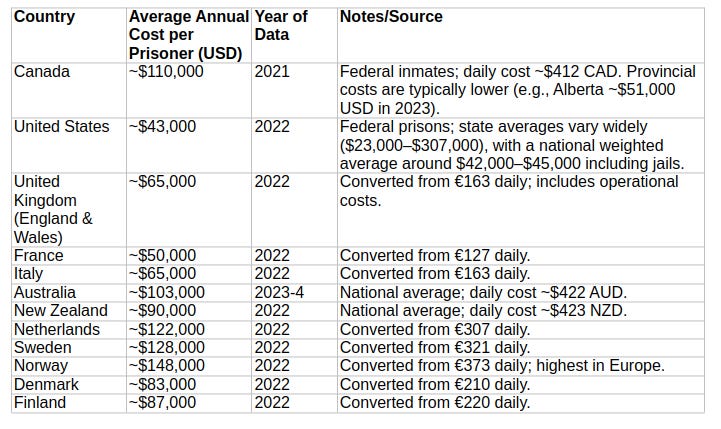From Stable Prisons to Skyrocketing Budgets: What's Really Happening at CSC?
Housing and handling Canada’s criminal offenders in federal detention facilities is expensive. In 2023, Correction Service of Canada (CSC) spent more than all but four federal departments (DND, CRA, RCMP, and Employment and Social Development Canada). CSC’s employment costs hit $2.4 billion that year and represented around 79 percent percent of their total $3.05 billion budget.
Average annual incarceration rates in federal facilities have remained more or less stable in recent years. There were 14,337 offenders being held on an average day in 2014-2015 vs. 13,463 in 2023-2024. Employment over that time was also more or less unchanged, climbing from 18,630 full-time equivalents in 2013 to 18,837 in 2023. Personnel expenses over those ten years increased from $2.0 billion to $2.4 billion - which is less than the inflation rate.
CSC spending is broken down into three sections:
Care and Custody, which refers to CSC’s responsibility to ensure the safe, secure, and humane confinement of federal offenders serving sentences of two years or more in correctional institutions (sentences of less than two years are served in provincial or territorial facilities).
Correctional Interventions, which are structured programs and services designed to reduce recidivism and prepare them for successful reintegration into society.
Community Supervision, or oversight of offenders who are released into the community under conditional release or long-term supervision orders.
Of those, the largest line item is Care and Custody. In 2014-2015, Care and Custody came to $1.47 billion. That amount grew to $1.54 billion in 2018-2019, $1.6 billion in 2020-2021, $1.99 billion in 2022-2023, and $2.6 billion in the 2025-2026 Main Estimates. The 2014-2015 spending would, when adjusted for inflation, total only $1.92 billion in 2025.
So while the numbers of both employees and offenders haven’t changed significantly - and employment spending hasn’t even grown to match inflation - the total costs of providing “Care and Custody” have somehow ballooned, increasing by 77 percent over the past decade.
You’d think that sifting through CSC vendor contract data might offer helpful insights. In 2024, third party contractors received 4,135 contracts worth a total of $654.7 million. By government standards, that’s not all that much. In fact, it’s a lot less than the $1.02 billion worth of contracts issued by CSC in 2019 and the $1.15 billion in 2022.
The fifteen largest single contracts in 2024 were all in the $6 million to $13 million range and none looked unusual or suspicious. By far the contract description that came up the most (983 times) was “Pharmaceutical and Other Medicinal Products”. The total cumulative value of those contracts was $45.3 million. Even a quick look through the list reveals that the sector is dominated by two related entities: the US-based pharmaceutical distribution company McKesson Canada Corporation with 810 contracts, and McKesson Specialized Distribution Inc. with 26 contracts. McKesson previously made news in the U.S. for being forced to pay hundreds of millions of dollars in settlements related to its role in the opioid epidemic.
Only 16 (out of 4,483) contracts went to “Indigenous Businesses” for a total combined contract value of just $1.5 million. A further 39 contracts went to vendors whose “Socio-Economic Indicator” was deemed a “Federal Contractors Program for Employment Equity”. The total value of those 39 contracts was $119 million, and they were largely made up of social service organizations like various John Howard societies and branches of the Salvation Army.
None of which helps us explain the recent explosion in CSC spending. But for what it’s worth, here’s an (unverified) comparison of the annual costs of managing custodial offenders paid by Canada and its peer nations:




Thanks for this cool analysis of available data. This is rather confounding, given that there is no clear factor in these data that is driving the rising budgets. It smells fishy, like there is something being hidden or unreported. If the prisoners, their pharma costs, and the labour needed to maintain the prisoners are all about the same or lower... what is driving the increased costs? Those would be my go-to factors that I would assume drove costs. Is it infrastructure (i.e. new build or repairs), perhaps? Are there post-secondary education / training costs that have increased? Transportation? Increased pay for management personnel? The only one of those factors that could really be driving this explosion in costs is infrastructure, but I am likely missing something here that might be behind it.
I've occasionally thought about a suggestion from a former colleague that we should contract out our prison services to Mexico. It would be considerably cheaper, much more of a disincentive to offend, and likely resulting in a significantly lower recidivism rate from the likelihood of one way bus trips. On a more serious note, our low productivity in this mirrors much of the deranged dominion compared to other jurisdictions.